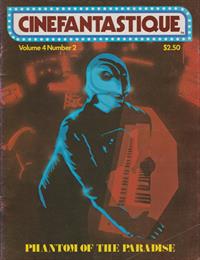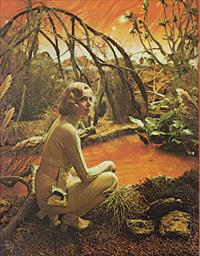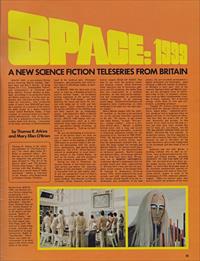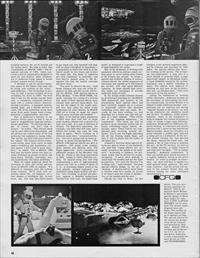A New Science Fiction Teleseries from Britain
Cinefastique - Volume 4, No. 2 1975 p44-46
by Thomas R. Atkins and Mary Ellen O'Brien
See also ... it's really disco, lost out there! Cinefantastique magazine, Volume 4, number 4
Article source provided by Curt Duckworth




Thomas R. Atkins is the editor and publisher of "The Film Journal," for which Mary Ellen O'Brien is assistant editor. Evidencing an interest in the genre, his magazine has published issues devoted to "The Art of the Horror Film" and "The Science Fiction Film Image," and his interview with Ray Bradbury appeared in a recent issue of "Sight and Sound." Atkins is chairman of the Theatre Arts Department at Hollins College, Virginia.
Space: 1999, a new science fiction series featuring Martin Landau, Barbara Bain, and Barry Morse, is being filmed for I.T.C. (Independent Television Corporation) at Pinewood and Bray Motion Picture Studios in England. According to its producers, Gerry and Sylvia Anderson, it is the most expensive and elaborate series ever devised for television, with production costs of more than $260,000 per hour. Set a quarter of a century in the future, the main locale is a space research center called Moonbase Alpha, a huge complex of command posts and experimental laboratories, with living quarters for a population of 300. Landau plays John Koenig, commander of the base; and Bain is Helena Russell, head of medical unit. Professor Bergman, astrophysicist and chief father figure at Moonbase Alpha, is played by Morse.
In Space: 1999 the dark side of the moon is used as a dumping ground for earth's nuclear waste. An accidental nuclear explosion in the series' first episode, The Void Ahead, [NOTE: This is an early version of what later became Breakaway] partially destroys the moon and hurls the portion with Alpha out of orbit and into deep space. Later episodes focus on the people stranded on the drifting base and their search for an inhabitable planet. Like Kubrick's 2001: A Space Odyssey, which has influenced the series, Space: 1999 begins with scientific possibilities, such as a self-sufficient lunar base, and then ventures into speculative fantasy involving, as Anderson phrased it, "Life as we don't know it."
We are not attempting a critical review of the series here- we have not seen any of the completed episodes- only a report on the making of Space: 1999 based on several visits to the studios and discussions with the producers, performers, and special effects designers. The I.T.C. series has been offered in syndication to local television outlets in the United States, as well as the world, and will premiere in most markets in September, 1975.
During our visit to Pinewood, the second episode of the 24 episode series was before the cameras, "Matter of Life and Death," concerning an encounter with an anti-matter planet and the unexpected return of Bain's husband, presumed lost on an earlier space mission. The director is Charles Crichton, whose features include the horror classic Dead of Night. The sets in use were the medical centre and mission control. Sleek futuristic white interiors full of electronic gadgetry and TV monitors, the Alpha Base sets are constructed on a modular principle, so that they can be dismantled and reassembled in practically endless variations. In an adjoining sound stage, Pinewood technicians and designers were constructing an alien landscape to be used for the anti-matter planet.
Barry Morse played with the mini-TV monitor on his belt as he surveyed for us the various futuristic machines on the set. "Of course, it isn't knobs that make drama," he said. "It's people...human conflict...even in a science fiction show." Morse, a skilled British actor with a long and varied career in film and television, is known to American audiences chiefly for his portrayal of Lt. Gerrard in The Fugitive. He has been impressed with the scripts for the science fiction show thus far and seemed confident that, despite the large budget for settings and special effects, the series would place more emphasis on the characters than on technical ingenuity. Martin Landau and Barbara Bain, performing together for the first time since their 80-episode run in Mission: Impossible, confirmed Morse's impression that the scripts would give them opportunities to develop their roles and that the gadgetry would remain in the background. In contrast to Anderson's previous series, UFO, which suffered from weak scripts and stiff performances, this new series should benefit from the individuality and credibility of its lead actors. All are excellent performers- highly motivated and believable, each bringing a different variety of emotional intensity to their part. One of the reasons Barbara Bain and Martin Landau are the strongest team in television today is that, in dramatic scenes, they work as ideal complements- Landau is tense, anxious, full of nervous energy, while Bain is cool and controlled, a soothing presence.
"Usually TV science fiction is budgeted first for special effects- monsters, space ships," explained executive producer Gerry Anderson when we talked with him in his Pinewood office, "and then they see what's left for the cast, directors, and scripts. In this series, we've tried to hire the best actors and then give them scripts that will let them act. Lee Katzin who did The Salzberg Connection and Le Mans, directed the first episode. In production values, the first segment is more like a feature film than a TV show because we had to introduce all the main characters, give some background on the moonbase, and then blast it out of orbit."
Anderson and his wife Sylvia, a striking redhead who is also an actress, have produced features for Universal and United Artists, including Journey to the Far Side of the Sun, but are best known for their model puppet series, such as Thunderbird[s], in which they developed many of the excellent miniatures special effects techniques now used in their live-action shows. Aware of some of the weaknesses of UFO, Anderson acknowledged, "Often we weren't quite sure how to resolve the problem in relationship between the sci-fi format and the human story. We hope to solve this relationship on Space: 1999. "The financial success of UFO, which concerns a secret organization designed to seek out and destroy alien invaders, led to Anderson being asked to invent another science fiction format.
"I decided to set the series 25 years in the future when man will be living and working on the moon," said Anderson. "Our technology is moving so fast it seems credible we'll be occupying the moon by 1999. The first idea I had for the series was the lunar city, a completely contained environment with a central control, interconnecting corridors, a transport system, landing pads, and a shuttle service to earth. All of the inventions on the show arise from some human need- transportation, companionship, survival."
Part of Anderson's interest in the science fiction genre is that it can be used to imaginatively express contemporary problems. "In entertaining people, of course, you don't want to preach," he stated. "But certain ideas can be very effectively illustrated, and the stories can reflect some of the real problems that mankind is facing today. The series can deal with man's search for values. The science fiction framework- being away from earth in outer space- heightens and dramatizes certain issues. I don't want to seem downbeat," he added, " but Space: 1999 may encounter aliens who have similar problems as people on earth- the same fears, hatreds, jealousies, sexual frustrations- the basic problems."
When we asked Anderson about the portrayal of other life forms and cultures on Space: 1999, he replied, "It's difficult to visualize alien life without being comical. We'll work with essences- plant life, for instance, or other shapes of intelligent life. A rock form, say, that may take 30 years to say thank you. One segment will deal with an alien conception on moonbase- a pregnancy in which the child is in the fourth month in two hours and is born the same day. The ideas or essences are first visualized in principle, and then they're passed along to the designers who take the mental concepts and draw them."
"You have to deceive the eye," said Brian Johnson who was one of the designers on 2001 and who is now directing the Space: 1999 special effects at Bray Studios. "I like Star Trek, but lately watching the reruns it's obvious that many of their special effects were cheaply done and now seem dated. You can see the edges of the model sets, and they kept using the same rocky landscapes for alien planets. In Space: 1999 we're trying to make the space effects more accurate and credible."
Most of the famous space sequences of 2001 were done with full or large scale models, filmed over a period of a year and a half, at a cost of millions of dollars. The Discovery spaceship, for example, was 54 feet long; and a 15 foot model was used for long shots in space. "We're working on a different scale here," commented Johnson, "yet we're paying just as much attention to detail and perspective." The Space: 1999 special effects are shot in miniature, with small scale models, photo cutouts, and tabletop sets. The Eagle spacecraft, which resembles an advanced version of the moonbus that took Dr. Floyd to the lunar excavation in 2001, exists in three different models, the largest being four feet long (representing a size of approximately 76 feet or a scale of about 19 to 1). A moonbase hangar scene in the first episode, Johnson explained, was simulated using Eagle models and photos, each receding in proper perspective, against a detailed background. Twenty-four feet wide, the Alpha Base model is designed to represent a width of approximately two miles.
One of the problems of working with miniature effects is motion- small models seem to move jerkily when filmed at 24 frames per second. To create a smooth and realistic illusion of motion, Johnson shoots the model sequences at extremely fast speeds up to 120 frames per second, with high speed Mitchell cameras. At these speeds high intensity lights are necessary to provide sufficient depth of field.
In his design studio Johnson showed us preliminary drawings for the Space: 1999 spacecraft and several of the storyboards. Each special effect had been carefully mapped out in a series of sequential cartoon-like sketches containing every shot and angle. Recently he has been working on test drawings for a black sun that will appear in a later episode. "This will be one of our toughest sequences," he commented. "The black sun will be pictured as an immense vortex that attracts everything- space debris, asteroids, stars. There will be one complicated shot involving several elements. You'll see the Eagle spaceship lift off the floating Alpha Base, and then it will be drawn into the centre of the black sun."
Johnson's theories about special effects are akin to those of Jim Danforth, who said that "visual effects are actually created in the minds of the audience." According to Johnson, the primary result that he strives for is psychological. "I never allow anybody to stand near the models and see the false perspective. Not even the director I'm working with," said Johnson, "because special effects design is the art of cheating. A person will be more likely to believe what he's seeing on screen if he hasn't seen the tricks of perspective on the models and the sets."
During our visit to Bray, we saw outages from several sequences planned by Johnson and executed by Nick Alder, the special effects film director working on the series. The screening was impressive: a long shot of a moon shuttle in graceful flight, a huge spacecraft hangar on Moonbase Alpha, a lunar landslide caused by the nuclear explosion, and a shuttle exploding in space. The effects were superior to anything we had seen so far on television and, as Johnson said, "they even look good on the big screen."
Among the limitations of working within television, Anderson brought up the necessity of interrupting the story for commercials (in Great Britain it is illegal to make arbitrary breaks: commercials can be inserted only during "natural" breaks in the story), as well as the relatively low definition sound and picture. In addition, unlike motion pictures, there is the temptation to stick to popular but cliched formulas in order to retain a huge mass following. Anderson illustrated the difference between working in television and motion pictures with a story he has heard from Martin Landau, about two version of a scene between a middle-aged man and a young girl in a restaurant. In the motion picture version the man peruses the menu, selects the finest wine, and spends a lot of time trying to impress the girl. In the TV version, as soon as the couple arrives, a waiter comes in and flips over the table. "TV is instant jeopardy," Anderson commented. "A film can unfold more slowly because of a captive audience sitting in the movie theater. In order to prosper on television, our show will have to appeal to a wide general home audience. We also hope, however, that the series will appeal to the science fiction fans and viewers looking for more intelligent entertainment."
Photo Captions:
Space: 1999 copyright ITV Studios Global Entertainment
Thanks to Robert Ruiz